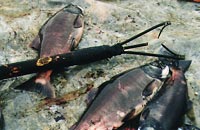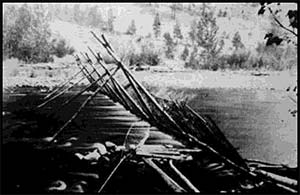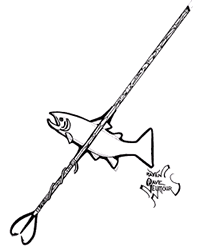
|
Fishing: Fish was another staple of the diet. The Secwepemc people caught and prepared all varieties of salmon, using the eggs as well as the flesh. Trout, ling cod, suckers and sturgeon were also caught. |
 |
| Salmon and Spear |
The Secwepemc caught salmon and other fish in rivers and lakes using nets, spears, gaffs, and lines with hooks.
They fished from rocks and from canoes. They also fished from platforms built at places where the fish hugged the shore while travelling upstream.
Many fish were caught at weirs (fences built in the water) and in several kinds of basket traps. At night, large trout and other fish were speared from canoes by torch light.
Dip Nets:
One method of fishing for salmon was to use a dip net. Nets were made of hemp or fibrous material from plants. When the salmon were travelling from the ocean to their predestined spawning grounds, families were set to harvest. Men would stand on rocks or platforms and using poles four metres long with a net at the end to catch the spawning salmon.
Basket fish traps:
Basket fish traps were made of willow and smaller branches woven together. These were secured in place using pitch and rawhide. They were placed at outlets of lakes or in streams. The base was two to three metres long and was cone shaped with a wide mouth tapering off. In the middle it narrowed so that the fish had just enough room to swim through. The small opening and the movement of the current passing through kept the fish inside the basket at the other end.
These baskets were also used to guide the fish into a corral. The corral was made of willow branches, sticks or netting and secured in place using stones. Other types of corrals used were as wide as the stream with a submerged willow gate at the front of the corral. Once the weight of the trout passed over the flexible willow gate it sprang back into an upright position trapping the fish. Besides this type of corral, another kind of entrance worked in the opposite way. Fish could easily swim beneath the twigs, but once through they acted like a trap door and the willows would rest back in place. The fish were trapped in the corral behind the opening.
 |
| Archival Photo of Fish Weir |
Fish Weirs:
Fish weirs looked like long fences constructed across streams. The fish swam up to the fence and collected in a pool. People used dip nets, gaff hooks made of stone or bone to scoop or spear the fish out of the water.
Pit Lamp Fishing:
Pit lamp fishing involved men in canoes floating on the river using torches of pitch-soaked wood to attract the spawning salmon. Usually a young boy kept the torches burning while the men either speared or netted the salmon out of the water.
Family members waited on shore to prepare the salmon after it was caught.
 |
| Fish with 3 Prong Spear |
Ice Fishing:
In winter, fish were caught through holes in the ice. Lines were made of fine material like deer sinew. Hooks were made of stone or bone with bait used to lure the fish. When the fish reached the hole, they were speared. To see the fish better, sometimes the people wore eyeshades. At other times, they covered their head and shoulders with a mat.
These are just some of the ingenious methods used by the Secwepemc to catch fish. Many of these methods are still used today. However, with technology, other materials are used in place of natural items.
|
|
